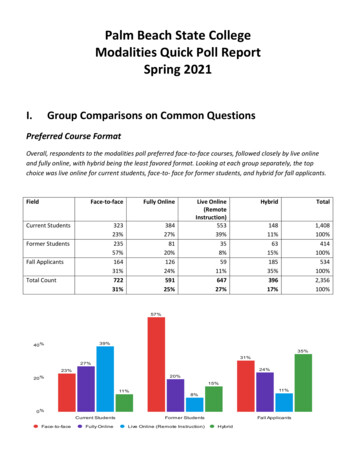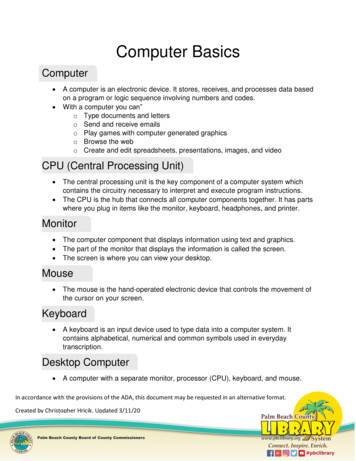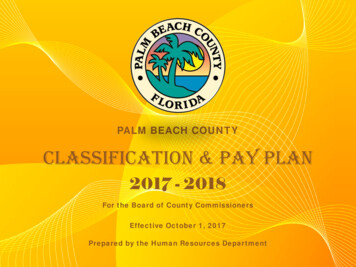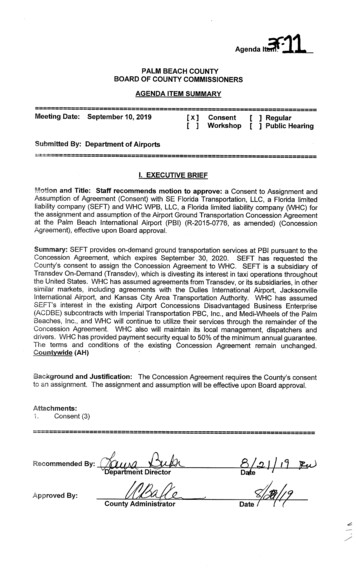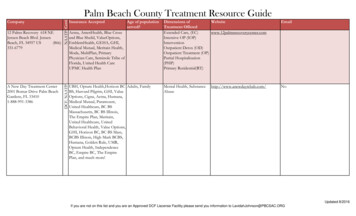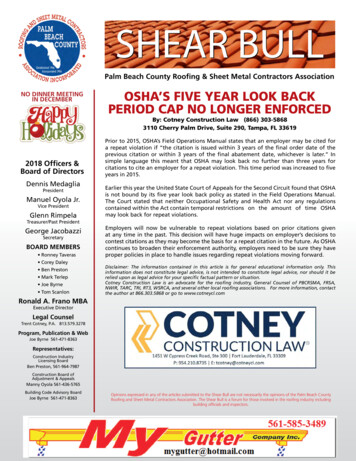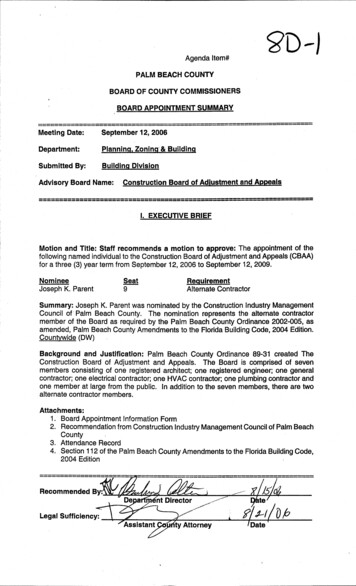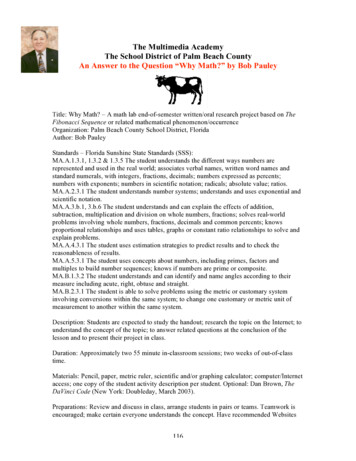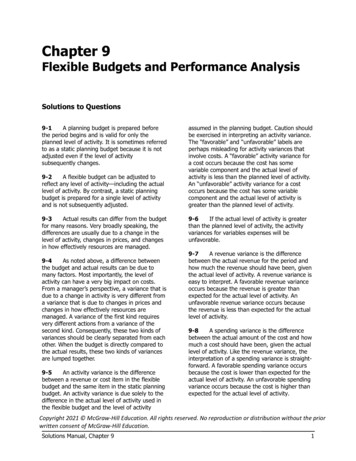
Transcription
Chapter 9Flexible Budgets and Performance AnalysisSolutions to Questions9-1A planning budget is prepared beforethe period begins and is valid for only theplanned level of activity. It is sometimes referredto as a static planning budget because it is notadjusted even if the level of activitysubsequently changes.9-2A flexible budget can be adjusted toreflect any level of activity—including the actuallevel of activity. By contrast, a static planningbudget is prepared for a single level of activityand is not subsequently adjusted.9-3Actual results can differ from the budgetfor many reasons. Very broadly speaking, thedifferences are usually due to a change in thelevel of activity, changes in prices, and changesin how effectively resources are managed.9-4As noted above, a difference betweenthe budget and actual results can be due tomany factors. Most importantly, the level ofactivity can have a very big impact on costs.From a manager’s perspective, a variance that isdue to a change in activity is very different froma variance that is due to changes in prices andchanges in how effectively resources aremanaged. A variance of the first kind requiresvery different actions from a variance of thesecond kind. Consequently, these two kinds ofvariances should be clearly separated from eachother. When the budget is directly compared tothe actual results, these two kinds of variancesare lumped together.9-5An activity variance is the differencebetween a revenue or cost item in the flexiblebudget and the same item in the static planningbudget. An activity variance is due solely to thedifference in the actual level of activity used inthe flexible budget and the level of activityassumed in the planning budget. Caution shouldbe exercised in interpreting an activity variance.The “favorable” and “unfavorable” labels areperhaps misleading for activity variances thatinvolve costs. A “favorable” activity variance fora cost occurs because the cost has somevariable component and the actual level ofactivity is less than the planned level of activity.An “unfavorable” activity variance for a costoccurs because the cost has some variablecomponent and the actual level of activity isgreater than the planned level of activity.9-6If the actual level of activity is greaterthan the planned level of activity, the activityvariances for variables expenses will beunfavorable.9-7A revenue variance is the differencebetween the actual revenue for the period andhow much the revenue should have been, giventhe actual level of activity. A revenue variance iseasy to interpret. A favorable revenue varianceoccurs because the revenue is greater thanexpected for the actual level of activity. Anunfavorable revenue variance occurs becausethe revenue is less than expected for the actuallevel of activity.9-8A spending variance is the differencebetween the actual amount of the cost and howmuch a cost should have been, given the actuallevel of activity. Like the revenue variance, theinterpretation of a spending variance is straightforward. A favorable spending variance occursbecause the cost is lower than expected for theactual level of activity. An unfavorable spendingvariance occurs because the cost is higher thanexpected for the actual level of activity.Copyright 2021 McGraw-Hill Education. All rights reserved. No reproduction or distribution without the priorwritten consent of McGraw-Hill Education.Solutions Manual, Chapter 91
9-9In a flexible budget performance report,the actual results are not directly compared tothe static planning budget. The flexible budget isinterposed between the actual results and thestatic planning budget. The differences betweenthe flexible budget and the static planningbudget are activity variances. The differencesbetween the actual results and the flexiblebudget are the revenue and spending variances.The flexible budget performance report cleanlyseparates the differences between the actualresults and the static planning budget that aredue to changes in activity (the activityvariances) from the differences that are due tochanges in prices and the effectiveness withwhich resources are managed (the revenue andspending variances).9-10 The only difference between a flexiblebudget based on a single cost driver and onebased on two cost drivers is the cost formulas.When there are two cost drivers, some costsmay be a function of the first cost driver, somecosts may be a function of the second costdriver, and some costs may be a function of bothcost drivers.Copyright 2021 McGraw-Hill Education. All rights reserved. No reproduction or distribution without the priorwritten consent of McGraw-Hill Education.2Managerial Accounting, 17th Edition
Chapter 9: Applying ExcelThe completed worksheet is shown below.Copyright 2021 McGraw-Hill Education. All rights reserved. No reproduction or distribution without the priorwritten consent of McGraw-Hill Education.Solutions Manual, Chapter 93
Chapter 9: Applying Excel (continued)The completed worksheet, with formulas displayed, is shown below.Note: For formulas to compute whether a variance is Favorable orUnfavorable, use the IF() function. For example, in cell D31, the formula is IF(E31 B31,"U",IF(E31 B31,"F","")). This formula first checks whetherthe actual revenue (cell B31) exceeds the revenue under the flexiblebudget (cell E31). If it does, the function returns the value F, which isdisplayed in cell D31. Otherwise, the function returns the value U, which isdisplayed in cell D31.When actual revenue is the same as under the flexiblebudget, nothing is displayed in cell D31.Copyright 2021 McGraw-Hill Education. All rights reserved. No reproduction or distribution without the priorwritten consent of McGraw-Hill Education.4Managerial Accounting, 17th Edition
Chapter 9: Applying Excel (continued)1. With the changes in data, the result is:Copyright 2021 McGraw-Hill Education. All rights reserved. No reproduction or distribution without the priorwritten consent of McGraw-Hill Education.Solutions Manual, Chapter 95
Chapter 9: Applying Excel (continued)a. The activity variance for revenue is 1,600 U. This variance is thedifference between the revenue under the planning budget and underthe flexible budget. It is unfavorable because the actual activity isless than the budgeted activity and consequently revenue should beless than planned under the budget.b. The spending variance for the cost of ingredients is 60 U. Thisvariance is the difference between what the cost should have beenaccording to the flexible budget and what it actually was for theperiod. It is unfavorable because the actual cost exceeded what thecost should have been.Copyright 2021 McGraw-Hill Education. All rights reserved. No reproduction or distribution without the priorwritten consent of McGraw-Hill Education.6Managerial Accounting, 17th Edition
Chapter 9: Applying Excel (continued)2. With the revised data, the worksheet should look like this:Actual activity exceeded planned activity by 100 meals served, whichshould have boosted net operating income by 925. However, actualresults were not this favorable. Given the actual number of mealsserved, the company should have realized net operating income of 2,650, but the actual net operating income was only 1,860, resultingin an unfavorable overall spending and revenue variance of 790.Attention should be focused on the lower than expected revenue.Copyright 2021 McGraw-Hill Education. All rights reserved. No reproduction or distribution without the priorwritten consent of McGraw-Hill Education.Solutions Manual, Chapter 97
Copyright 2021 McGraw-Hill Education. All rights reserved. No reproduction or distribution without the priorwritten consent of McGraw-Hill Education.8Managerial Accounting, 17th Edition
The Foundational 151. The amount of revenue in the flexible budget for May is:Revenue:Variable element per customer served (a).Actual activity (b) .Amount in flexible budget (a) (b) . 5,00035 175,0002. The amount of employee salaries and wages in the flexible budget forMay is:Employee salaries and wages:Variable element per customer served (a).Actual activity (b) .Variable portion of the amount (a) (b) . 1,10035 38,500Variable portion of the amount .Fixed element per month .Amount in flexible budget . 38,50050,000 88,5003. The amount of travel expenses in the flexible budget for May is:Travel expenses:Variable element per customer served (a).Actual activity (b) .Amount in flexible budget (a) (b) . 60035 21,0004. The amount of Other Expenses included in the flexible budget for Maywould be the fixed element per month of 36,000.5. The net income reported in the flexible budget can be derived bycombining the answers to questions 1-4 as follows:Revenue .Employee salaries and wages .Travel expenses .Other expenses .Net operating income . 88,50021,00036,000 175,000145,500 29,500Copyright 2021 McGraw-Hill Education. All rights reserved. No reproduction or distribution without the priorwritten consent of McGraw-Hill Education.Solutions Manual, Chapter 99
The Foundational 156. The revenue variance for May is:Actual results 160,000Revenue Variance 15,000 UFlexible Budget 175,0007. The employee salaries and wages spending variance for May is:Actual results 88,000Spending Variance 500 FFlexible Budget 88,5008. The travel expenses spending variance for May is:Actual results 19,000Spending Variance 2,000 FFlexible Budget 21,0009. The other expenses spending variance for May is:Actual results 34,500Spending Variance 1,500 FFlexible Budget 36,00010. The amount of revenue in the planning budget for May is:Revenue:Variable element per customer served (a).Planned level of activity (b) .Amount in planning budget (a) (b). 5,00030 150,00011. The amount of employee salaries and wages in the planning budget forMay is:Employee salaries and wages:Variable element per customer served (a).Actual activity (b) .Variable portion of the amount (a) (b) . 1,10030 33,000Variable portion of the amount .Fixed element per month .Amount in planning budget . 33,00050,000 83,000Copyright 2021 McGraw-Hill Education. All rights reserved. No reproduction or distribution without the priorwritten consent of McGraw-Hill Education.10Managerial Accounting, 17th Edition
The Foundational 1512. The amount of travel expenses in the planning budget for May is:Travel expenses:Variable element per customer served (a).Actual activity (b) .Amount in planning budget (a) (b). 60030 18,00013. The amount of Other Expenses included in the planning budget forMay would be the fixed element per month of 36,000.14. The activity variance for revenue for May is:Flexible Budget 175,000Activity Variance 25,000 FPlanning Budget 150,00015. The activity variances for the expenses for May are as follows:Employee salaries and wages .Travel expenses .Other expenses .FlexibleBudget 88,500 21,000 36,000ActivityVariance 5,500 U 3,000 U 0PlanningBudget 83,000 18,000 36,000Copyright 2021 McGraw-Hill Education. All rights reserved. No reproduction or distribution without the priorwritten consent of McGraw-Hill Education.Solutions Manual, Chapter 911
Exercise 9-1 (10 minutes)Puget Sound DiversFlexible BudgetFor the Month Ended May 31Actual diving-hours .105Revenue ( 365.00q) .Expenses:Wages and salaries ( 8,000 125.00q) .Supplies ( 3.00q) .Equipment rental ( 1,800 32.00q) .Insurance ( 3,400) .Miscellaneous ( 630 1.80q) .Total expense .Net operating income. 38,32521,1253155,1603,40081930,819 7,506Copyright 2021 McGraw-Hill Education. All rights reserved. No reproduction or distribution without the priorwritten consent of McGraw-Hill Education.12Managerial Accounting, 17th Edition
Exercise 9-2 (15 minutes)1. The activity variances are shown below:Flight CaféActivity VariancesFor the Month Ended July 31Meals .Revenue ( 4.50q) .Expenses:Raw materials ( 2.40q) .Wages and salaries ( 5,200 0.30q) .Utilities ( 2,400 0.05q) .Facility rent ( 4,300) .Insurance ( 2,300) .Miscellaneous ( 680 0.10q).Total expense .Net operating income .FlexibleBudgetPlanningBudget 80,100 81,000 10 14,49010,6003,3004,3002,3002,48066,180 14,82060100020570 330FF17,80018,000ActivityVariancesFFU2. Management should be concerned that the level of activity fell belowwhat had been planned for the month. This led to an expected declinein profits of 330. However, the individual items on the report shouldnot receive much management attention. The unfavorable variance forrevenue and the favorable variances for expenses are entirely caused bythe drop in activity.Copyright 2021 McGraw-Hill Education. All rights reserved. No reproduction or distribution without the priorwritten consent of McGraw-Hill Education.Solutions Manual, Chapter 913
Exercise 9-3 (15 minutes)Quilcene O
6 Managerial Accounting, 17th Edition Chapter 9: Applying Excel (continued) a. The activity variance for revenue is 1,600 U. This variance is the difference between the revenue under the planning budget and under the flexible budget. It is unfavorable because the actual activity is less than the budgeted activity and consequently revenue should be less than planned under the budget. b. The .

